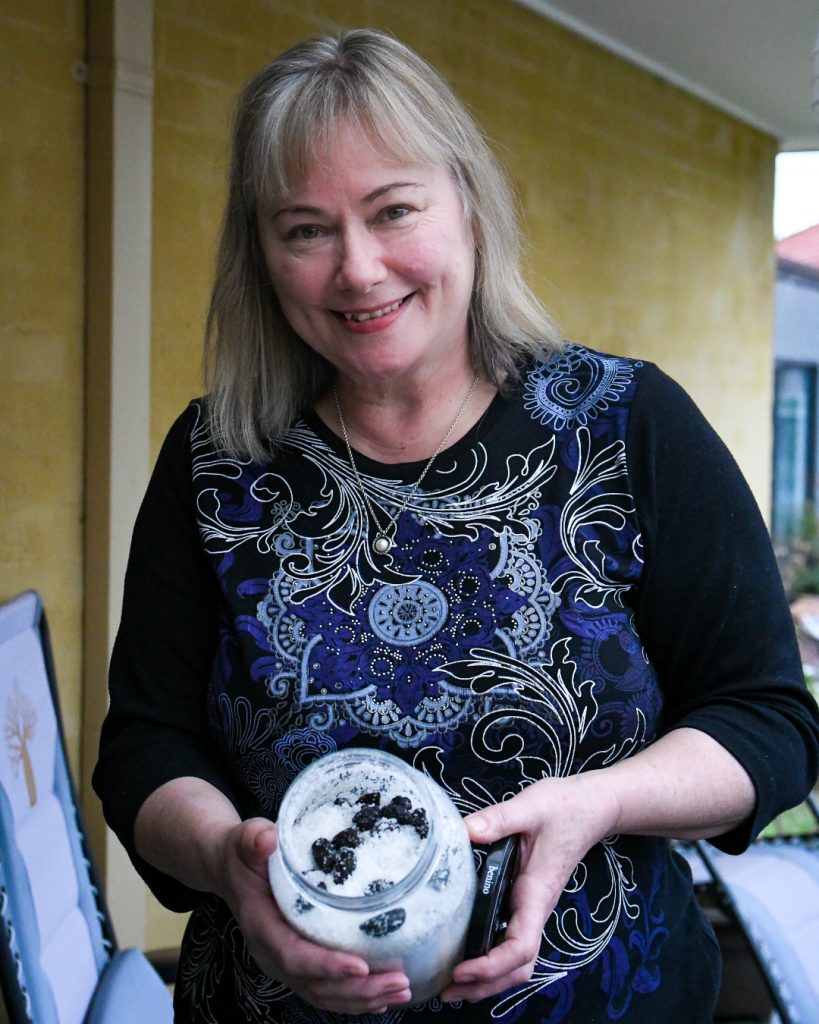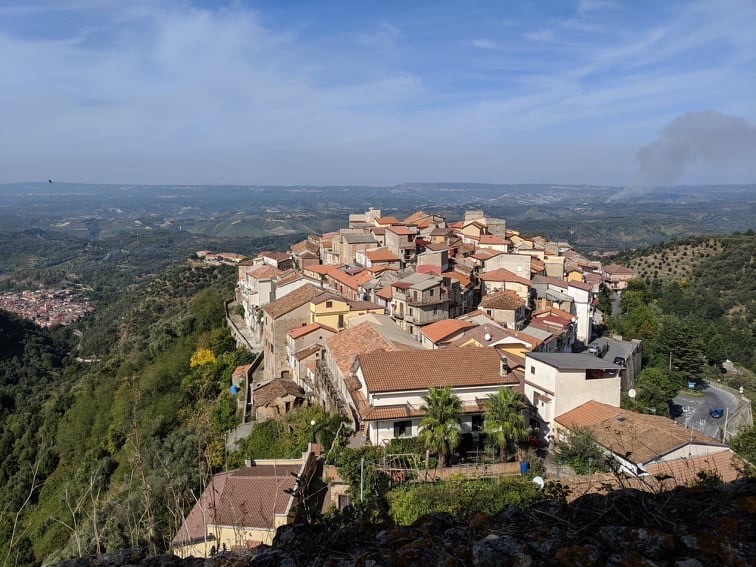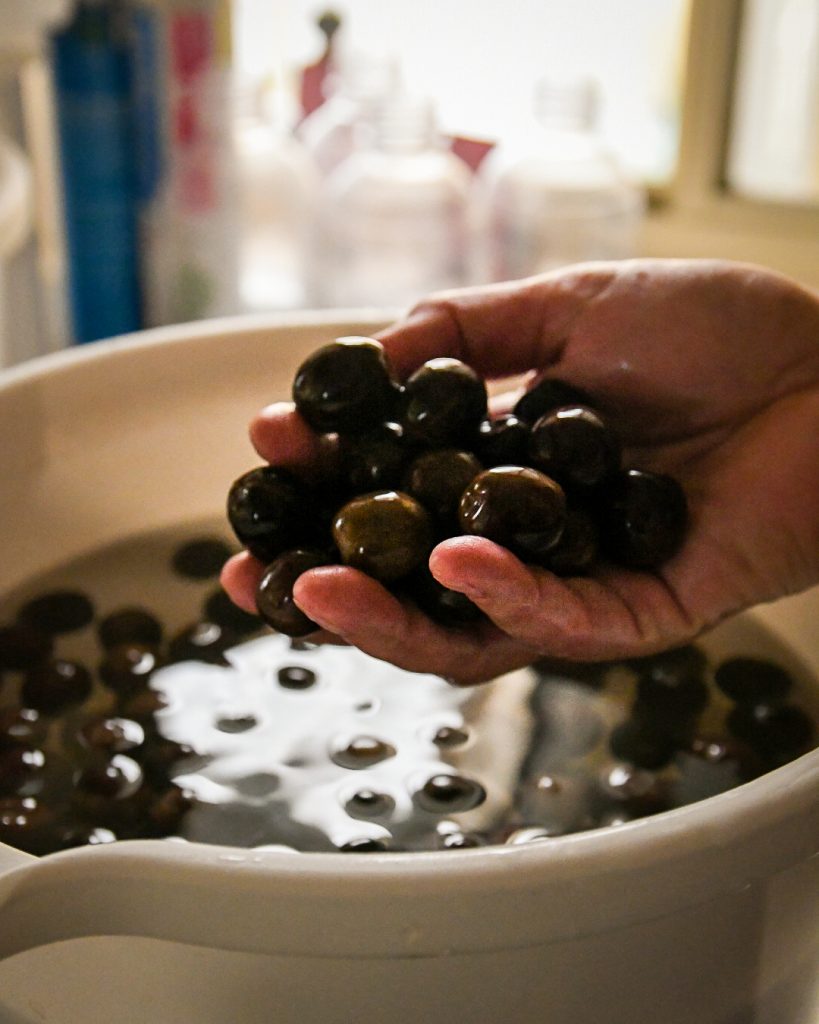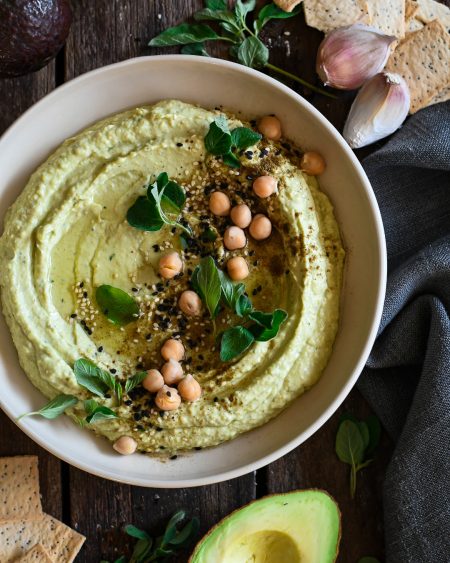You don’t have to look very far in Canberra to find someone of Italian heritage. Just yell out the word “Nonna!” at the markets on a Saturday morning and watch heads turn. And when you spot one, ask them how they prepare their olives. You’ll be glad you did.
Despite the name, Helen Agostino was not born into a big, Italian family. Like many people in Australia, she married into one. She speaks so warmly of her Italian mother-in-law, Mariantonia, who accepted her with open arms and shared all her culinary secrets: her famed lasagne, the carefully made rice croquettes that were so simple but utterly delicious and – of most interest to me – the way she prepared her olives.
I met Helen through our shared love of food and photography. She reached out to me a few months ago, during the annual olive harvest on her family’s Murrumbateman property, asking if I’d like to see how she preserves her crop.
I was at her door in a flash.

Helen grew up in Tasmania to English and Scottish parents who emigrated here after the war. A keen linguist, Helen ended up at the ANU on a teaching scholarship where she met her husband, Tony, an Italian from the Calabria region.
Coming from quite different backgrounds, Helen embraced all things Italian both studying the language at night school and learning the traditional ways of Italian gastronomy at his mother’s instruction. “She was such a proud woman but so self-deprecating when talking about her food – even the most magnificent lasagne was declared ‘too soft’ as she presented it to her guests.” Can anyone else with a European mum relate? I can!

It’s delightfully familiar hearing about the way Mariantonia built her life, here in Canberra, safeguarding all the important things she had learned to love back home in Italy. Helen laughs at the memory of an aerial photograph taken of the suburb of Weetangera, with its many landscaped pools and tennis courts. “My mother-in-law had no time for these things; her beautiful vegetable garden with its olive trees stood out, taking pride of place in her backyard.”
As with most migrants, eventually they made a pilgrimage back to the secluded, mountainous village of Tony’s birth, Arena. “Tony hadn’t been back since he was nine years old, so it was an emotional experience. I was amazed that he could still remember how to find his old house and school.” Imagine the joy and flood of emotions, being back on those familiar streets after many decades.
With an ageing population, apparently it only took about ten minutes for the old people of Arena to spread the word that Tony had returned. Soon everyone knew and people came streaming from their homes to investigate. From my experience of old Italians, this sounds about right. Pronto!

Retelling the story of their visit to Arena paints delightful images straight out of a Fellini movie: Pino the cab driver, in his bright red pants, picks them up in a little taxi and drives the wending mountain roads to the walled village.
Upon learning that Tony has never received his birth certificate, Pino marches them right into the town hall and they immediately have an audience with the Mayor of this tiny town. In my head, Pino is played by Roberto Benigni, it’s a loud and slightly comical encounter that ends in a staged photo which, in my mind, is taken with a flash bulb on a vintage camera. Of course, there’s wine.

Now back to the olives.
You’d be forgiven for thinking that the preserved olives available at delis and supermarkets are how the fruit ripens on the tree. Many a Tuscan dream has been ruined by naively biting into a freshly picked one, mouths puckering at its natural bitterness.
There are, in fact, several preparation methods to make olives shelf stable and remove the unwanted, acrid flavour. Most commonly they are soaked and stored in a mix of water and salt. That’s a little oversimplified and I’m sure Italians everywhere are cringing but, you get the idea.

Helen has olives all over the kitchen in meticulously arranged jars and tubs… along with the plethora of kitchen appliances she has won in food photography competitions over the years. (I digress a little but, honestly, I was floored: a thermomix, an oven, an air fryer, a cooktop and countless other vouchers and prizes. I want to give Helen a little squeeze, just for luck!)
“Have you ever tried date olives?” She produces a massive jar, filled with coarse salt and a few shiny olives peeking through. This is another way of extracting bitterness (surely there is a metaphor in there somewhere). Every day the jar is shaken, a task she assures me that children enjoy.
After about a week, they are rinsed before being placed in a low oven for about twenty minutes. The result is a warm dried olive, not dissimilar in taste to a standard Kalamata but with an intensified flavour and slightly chewy texture. Beautiful on a cheeseboard or just as a snack.
Or eaten by the handful as we move to the next olive station in her home.

An old book emerges on Italian Preserves. Helen remembers fondly the traditional village ways she learned from her mother-in-law, which must have seemed so unusual compared to her English/Scottish upbringing in Tassie.
“Mariantonia made all kinds of olives but she particularly loved making traditional Schiacciate with fresh green olives, always insisting that each one be crushed with the base of a beer bottle – no other implement would do.” Even though she hasn’t been around for a while, Helen and her family still do it that way today.
Schiacciate is completely new to me and I’m immediately intrigued by this revolutionary concept: fresh olives are only soaked in clean water for a week – no salt, no maturation time – before being dressed much like any other salad ingredient and eaten immediately.
Imagine a buttery olive without the expected saltiness. Owing to the less intense flavour, the olive now acts as a salad component, pairing perfectly with a more traditional dressing of olive oil, garlic, lemon and fennel. Oh! And chilli. Lots of chilli. Tony’s village is famous for the red chillies that grow there. The people of Arena refer to them with the rather indelicate gastronomical title of ‘fast eats’ – a nod to how quickly they are eaten and… digested.
Ordinarily you can only make Schiacciate with freshly picked olives but, short of buying my own olive grove, I was determined to find an easy way to replicate the concept. After some experimentation (which may not meet Nonna Mariantonia’s exacting standards) I’m happy to say that I’ve created a recipe to make this amazing dish at home. It involves soaking store-bought olives in water and I’m thrilled that it has met with Tony’s approval!
As I left that day, arms piled high with European hospitality in the form of olive goodness, I was grateful for the passing down of these traditions: from a secluded village in Italy via Tasmania, Canberra and now part of a repertoire in my own multicultural home. I asked Helen how Mariantonia would have felt to be part of this article and she giggles. “She would have thought it was fabulous, but definitely followed up with her usual catchcry ‘Ah! You crazy!’”
A massive thank you to Helen for sharing this beautiful food story with me. I’ve been invited back to the olive harvest next year and I’ll be there, camera in hand! If you would like to follow Helen and her gorgeous food photography, you can find her @pearler60 on Instagram.

Schiacciate Style Green Olive Salad
Not many of us have access to our own olive grove and, even then, they’re only available at one time of the year. This recipe emulates the schiacciate style of preparation for green olives by soaking store bought olives in water to remove the salty brine. Doing so allows the olive to soak up the chilli and spices in the dressing while maintaining its rich olive flavour and texture.
Ingredients
2 x 500g jar pitted green olives, approximately
1 small bulb fennel
1 ripe tomato
½ teaspoon dried chilli flakes
½ teaspoon dried oregano
½ teaspoon fennel seeds, crushed slightly
¼ cup olive oil
1 clove garlic, crushed
Juice of ½ a lemon
Fresh parsley and oregano for garnish
Salt and pepper
Method
Drain the olives and rinse well with cold water. The idea is to remove as much of the salty brine as possible. Place in a large glass jar or container with a lid. Cover with clean water and allow to sit in the fridge for a few hours or, better yet, overnight.
When the olives are ready, drain and rinse then set aside.
Make the salad dressing directly into the serving bowl by combining chilli, oregano, fennel seeds, garlic, olive oil and lemon.
Slice the fennel very finely on a mandolin and add to the dressing, tossing everything to combine.
Cut the tomato into wedges and add to the salad. Tomato always tastes best at room temperature so, if you have stored it in the fridge, allow to come to room temperature first.
Finally, add your olives to the salad bowl. Toss once more, adding salt and pepper to taste. Garnish with a generous amount of fresh parsley and oregano before serving.






